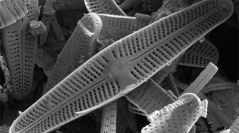

 Cryptogamie, Algologie
43 (10) - Pages 147-176
Cryptogamie, Algologie
43 (10) - Pages 147-176Six species of the genus Achnanthidium Kütz. with straight terminal raphe fissures including Achnanthidium caledonicum (Lange-Bert.) Lange-Bert., A. sieminskae Witkowski, Kulikowskiy & Riaux-Gob., Achnanthidium neomicrocephalum Lange-Bert. & F.Staab and Achnanthidium minutissimum (Kütz.) Czarn. were studied using light and scanning electron microscopy, and shape analysis. The type of Achnanthes microcephala f. scotica J.R.Carter (synonym: A. caledonica) and a population of A. neomicrocephalum from its type locality were investigated. Two new species, Achnanthidium tirolense sp. nov. and Achnanthidium lacuslustense sp. nov., found in two oligotrophic lakes in Germany and Austria, were described. Achnanthidium tirolense sp. nov. is distinguished by its rhombic-lanceolate valves with a slightly inflated valve centre and an acute-angled fascia on the raphe valve, and Achnanthidium lacuslustense sp. nov. by its large capitate poles, broad fascia on the raphe valve and strongly curved frustules. The distribution of A. caledonicum, A. sieminskae, A. neomicrocephalum and A. minutissimum in relation to land use and their species associations were investigated in 52 rivers, streams, and lakes of Scotland. Achnanthidium sieminskae, A. caledonicum, and A. neomicrocephalum were found in areas with low human impact where seminatural vegetation was dominant. The latter two species are typical in mountainous areas. In contrast, A. minutissimum sensu stricto was found in locations where human impact was greater. Although further data are required to determine which environmental variables underlie these distributions, our results suggest that the treatment of these species should be revised in ecological status assessments, and taxa aggregated under A. minutissimum sensu lato should be distinguished in ecological and biogeographical studies.
Europe, Achnanthidiaceae, species distribution, new species